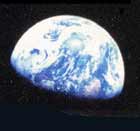|
The successful precedent: the ozone “hole”
Life on earth is shielded from most of the sun's ultraviolet radiation
by an ozone-containing layer at a height of around 20,000 feet.
(Ozone molecules are made of three oxygen atoms; there is one ozone
molecule to about 100,000 other molecules in the surrounding air.)
Industrial chemicals, especially halons
and the chlorofluorocarbons used in refrigerators and spray cans,
rise and destroy the ozone. That this was happening became suddenly
clear in 1985 when laborious measurements made by three researchers
at the British Antarctic Survey's Halley station showed that over
Antarctica, where special conditions in spring hurry the process,
ozone had thinned by 40 percent in a decade. The discovery nearly
didn't happen: the Conservative government of Mrs. Thatcher was
busy cutting funds for science like this.
Scared by the prospect of blinding eye cataracts
and fatal skin cancers, the world agreed in 1987 to the Montreal
Protocol, which would phase out ozone-destroying chemicals.
By 2009 all UN members had signed, and production of those chemicals
has dropped by 95 percent. The "ozone hole", which had looked like
spreading across the world, has not gone away, nor have the ozone-destroying
gases, but they have leveled off and the layer may recover by 2100.
Ozone depletion is a separate problem, not
to be confused with global heating. It does have an unfortunate
interaction with global heating: the chemicals and some of those
used to replace them are also greenhouse gases, up to 10,000 times
more so than carbon dioxide.
Still, the Montreal Protocol has been called
"the most successful international environmental agreement". It
shows that we can do it.
return
|

